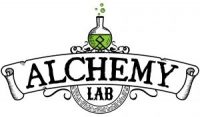Modern Alchemical Art
Statements by the Artist, Kurt Godwin
Return to Modern Alchemical Art
The Carousel/Alchemy Series of Paintings (1997-1999)
The Relationship Between the Carousel and Alchemical Imagery
The carousel has several universal connotations generally dealing with the idealized innocence of youth. As a ride that revolves, (similarly with the Ferris wheel), its circular path may also be symbolic of the Wheel of Life. This is particularly true if one includes the metaphor of the riders’ goal of grasping the golden ring.
The fantastic, surrealistic images of the 17th-century alchemy text “The Twelve Keys of Basil Valentine” were intentionally heavily coded, metaphorical allegories that pertain to the procedures of the alchemical Great Work. This Great Work has been interpreted as achieving the ability to turn base metal into gold. While the true definitions of these mysterious pictures are now lost to us, Jungian psychology has identified this type of image as universal archetypes of the collective unconscious. A more complete assessment of alchemy and the imagery related to it is in the personal search and struggle for a higher self-awareness, a purpose believed to be the actual, primary goal of the true alchemical philosophers.
In this way I construe these two images to be related: The carousel depicts the “conscious” world image of life’s path and the alchemical image depicts the “unconscious” spiritual counterpart. This is also an example of the alchemist’s search for the union of opposites. The origins of the carousel as a device to train medieval royal youth in the ways of war presents another dichotomy in combination with its more well known, carefree associations.
The alchemy images used are reproduced in their original form, treated as flat, two-dimensional drawings to reinforce their roles as symbols. Superimposed over the carousel, the alchemy image takes on the colors of the carousel, altering them where they overlap. The interplay of the “real” and the “imagined” blurs and shifts. Traditional ideas associated with figurative painting are subverted. Perspective space is implied yet confounded with ambiguity. The vanishing point of a horizon does not exist.
This imagery woven together, combined with the orchestrated systems of color combinations, results in structures closer to the mandala than Western pictorial devices. Although the content derives from Western civilization, the suggestion of contemplation, meditation with this work is of Eastern origin. As with the yin/yang icon, the Eastern symbol for the unification of opposites, it becomes clear how profound yet simple elemental truths can be. As we face our unknown future, it is important to realized the essence of some forgotten truths from the past.
The Twelve Keys: A Description and Partial Interpretation of Their Symbology
Basil Valentine was supposedly a 15th-century Benedictine monk. Most likely the name is a pseudonym. The Twelve Keys are twelve steps in the overall alchemical process. Some of these illustrations are allegorical overviews of the practice while others are specific to the task at hand, like scientific formulae. The following is a partial interpretation of the Twelve Keys.
The goal of these twelve steps is to achieve the Philosopher’s Stone. The Stone has three components: body, soul, and spirit, which are joined together in four phases. In phase one (Sublimation) body unites with spirit. In phase two (Fermentation), the spiritized body unites with the soul. Phase three (Exaltation) unites body, soul, and spirit. Phase four (Multiplication) unites soul and spirit.
I have uncovered some of the meaning behind the symbolism in the illustrations and have included them with the relevant key. Some images can be interpreted differently, as they have several meanings. Other images remain a mystery for now.
| Key One | Key Seven |
| Key Two | Key Eight |
| Key Three | Key Nine |
| Key Four | Key Ten |
| Key Five | Key Eleven |
| Key Six | Key Twelve |
The Philosophy of Nature – A Series of Paintings
This series of paintings is the next phase of work that began with the two consecutive bodies of work, the Twelve Key of Basil Valentine and the Glass House. The basic premise of this new series is the overlay of alchemical and modern scientific diagram counterparts regarding similar thoughts and principals. In other words, the Laws of Nature have just been interpreted with a similar focus and passion — just in different modes that reflect the times from where they originate. How they interweave visually is what interests me.
~ Clearing (60” X 36” – mixed media on canvas)
This is a juxtaposition of 17th c. philosopher/physicist Robert Fludd’s (1574 -1637) unique interpretation of the ancient Cabala Tree of Life diagram with diagrams of time clock mechanisms. The rotary gears on either side of the inverted Tree of Life date back to 14th c. and the invention of the mechanical clock. Suspended over the air borne roots are diagrams indicating the workings of the pendulum clock invented, an over the original devise, by Dutch astronomer Christaan (sic) Huygens in 1656. If the study of the Cabala can be explained in part as mystical/spiritual evolutionary process it can be illustrated as a devise of time as well as space.
~ Confluence of Time (46” X 52” acrylic/oil on canvas)
This painting is a literal, visual interpretation of a quote from esoteric philosophical scientist and scholar, Rudolph Steiner (1861 – 1925). In a late 19th century speech he stated: “As we sit here today, you have a certain sum of experiences. At the same time tomorrow, the sum of these events will be different. Now imagine that the experiences you will possess tomorrow are already there. Becoming aware of them would be like seeing a panorama of events coming toward you in space. Imagine that the stream coming in from the future is bringing you the experience you have today and tomorrow. At any point in time, two streams flow together to form your life. One stream flows from the future toward the present and the other from the present toward the future, and an interface occurs wherever they meet. Anything that still remains for us to experience in our life appears in the form of astral phenomena, which makes a tremendous impression on us.” [* Rudolph Steiner, The Fourth Dimension, Sacred Geometry, Alchemy and Mathematics (Anthropomorphic Press: 2001), p.22]. The mechanical diagram hovering above the illustration of the sentiment is that of the cycle of a de-humidifier. Placed over the conjunction of the streams of the past and future is to signify the position of the present. This mechanism was chosen as it keeps the surrounding air at a constant. The weather map is from June 4, 2004 in Germany – a time period coinciding with my travels there. The alchemical vessel illustrations on either side of the waterfalls indicate the consecutive process of the Great Work while also adding additional symmetry for visual balance.
~ Devil’s Bridge (Deconstruction) (64” X 62” acrylic on canvas)
Based on a painting by Karl Blechen (1798 – 1840) of an actual bridge that still exits connecting Switzerland and Germany. Folklore has it the Devil would only let the bridge construction precede if he could have the soul of the first one to cross it. The town’s people fooled the Devil by sending across a pig. Infuriated he threw a huge boulder into the river below where it remains today. The scientific diagrams that over lap the bridge imagery include the dynamics of an earthquake, the formation of igneous and metamorphic rock and the Jet Stream. Situated below the bridge is an icon conceived following the 12 Key series, The Glass House. Within the Glass House is an earlier conceptual image of the side view of a wheel about to hit the ground. It is the wheel’s shadow that informs what the object is. The inclusion of these older images was a conscious attempt to provide a “bridge” between my past and current works thus creating a concrete continuum.
~ Mighty Like the Rose (54” X 56” acrylic on canvas)
The great Rosicrucian Rose icon of Robert Fludd is overlapped with a diagram indicating a cross section of planet Earth and the constant arc of the magnetic field emanating through its core. Above are diagrams of cloud cross sections depicting how lightning and thunder are discharged from positive and negative ions.
~ Philosophy of Light (58” X 42” acrylic on canvas)
Overlapping a hermetic image associated with the German mystic Jacob Bohme (1575 – 1624) is a diagram defining the how we perceive the Northern Lights phenomenon through crystals that form in the atmosphere under certain conditions. Situated in the lower right hand section of the painting is the symbol portraying the human figure can be seen taking in this spectacle. {Side note: The period of time I was working on this painting coincided with the production of the Jim Beam distillery’s ten- millionth barrel of bourbon. The Beam family originated in Germany – immigrated to America and settled in Kentucky. The founder of the distillery was Jacob Beam (1770 – 1834). Before the spelling was changed the Beam the last name was spelled Bohme. It is interesting note, in addition to this interesting coincidence, that the distillation of spirits had its origins through the art of alchemy.}
~ Philosophy of Nature (72” X 96” triptych, total dimensions – acrylic on canvas mounted on panels)
~ Left panel = The dynamics of a hurricane overlap a photographic based image of trees damaged by a hurricane. This occurred near my home. The broken branch hanging down is contradictorily both reminiscent and the antithesis of Fludd’s inverted Tree of Life.
~ Right panel = This panel is based on the same right panel tree image yet reversed. Within the tree is suspended is the Cabala based on a three- D model of the Cabala. This concept originated by visualizing the classic Cabala diagram imagined as an architectural blue print. That is such a 2-D drawing represents a 3-D structure. Rendered in this fashion the Cabala is reminiscent of models of atomic/sub-atomic structures.
~ Center panel = Based on an alchemical emblem, sometimes attributed to Basil Valentine, two Philosophers confer under another interpretation of the Tree of Life that includes a series of signs of metals. Above are cross-sections of clouds depicting the process of how rain. Sleet and snow develop.
~ Rake’s Progress (Churn) (52” X 52”)
A large confusion of man-made objects has been raked to the side of a labyrinth designed after the one at the Chartes Cathedral in France. Emanating from below the center of the maze is a diagram illustrating the sun and the solar wind it projects that is deflected from directly penetrating Earth’s atmosphere because of the planets surrounding electric magnetic fields of the Van Allen Belt.
~ Sugar Blue (38” X 48” oil and acrylic on canvas)
Astronomers training telescopes towards the center of the Milky Way were surprised to discover traces of a simple form of the molecule that is related to sugar. Nothing related to an organism was expected to survive in this intensely dark and frigid space. The shapes and colors that form the field of this composition are a reproduction of the radio-telescope image of the area in question. The rendered molecule model is that of simple sugar. It has been postulated that a meteor passing through this region of space could conceivably catch some of this material and carry it on ward. If it crashed into a planet it would expose a possible building block of life. The alchemical emblem overlaid in red is from Michael Maier’s (1566 – 1622) opus Atalanta fugiens of 1618. This emblem portrays the omnipresence of the Philosopher’s Stone, prevalent yet unseen by Mankind in general. Additionally this image was a natural choice, as the cubes resemble sugar cubes.
The original works described in this section are for sale directly from the artist, Kurt Godwin [email protected] . The artist also welcomes feedback and comments on the alchemical significance of his work. Please note that all artwork in this section is copyrighted. © Kurt Godwin 1999. All Rights Reserved.





